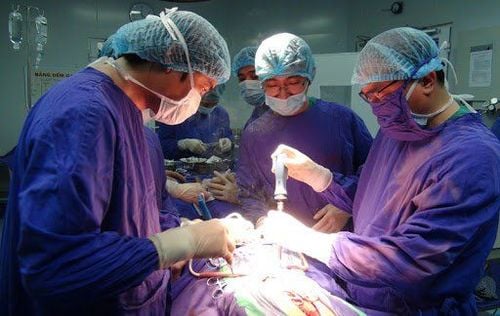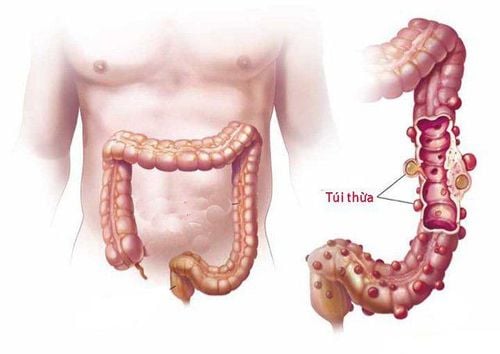This is an automatically translated article.
Surgery is the mainstay of treatment for mesenteric tumors. There are two types of laparoscopic mesenteric tumor resection: laparoscopic mesenteric tumor resection without small bowel resection and laparoscopic mesenteric tumor resection with small bowel resection.
1. In what cases is laparoscopic mesenteric tumor resection indicated?
Mesenteric tumor is a rare disease, the probability of occurrence is 1/27,000-1/100,000 people. Although rare, mesenteric tumors can occur at any age, especially in young people from 20-40 years old, the rate of women is more than that of men. Benign mesenteric tumors often develop silently, the disease is discovered incidentally when palpated or examined by the physician. The patient may have some symptoms such as mild abdominal pain, digestive upset, pain radiating through the shoulder and spine. Patients with malignant tumors will have symptoms of fatigue, weight loss, loss of appetite, anemia.
Regarding the treatment of mesenteric tumours, surgery is the best method, helping to treat thoroughly, avoiding complications and affecting neighboring organs. The combined surgical and therapeutic strategy will be determined based on the nature of the tumor, its relation to adjacent structures, and the symptoms associated with the tumor.

U mạc treo ruột thường gặp ở người trẻ
Laparoscopic mesenteric resection includes two types: laparoscopic mesenteric resection without small bowel resection and laparoscopic mesenteric resection with small bowel resection. Laparoscopic mesenteric tumor resection without small bowel resection is indicated for benign mesenteric tumors with no possibility of malignancy. Laparoscopic mesenteric tumor resection with small bowel resection is often indicated in cases of mesenteric tumours that are malignant or potentially malignant.
Cases of mesenteric tumours that are not indicated for surgery are:
Lymphangiomas with few symptoms or with uncertain resectability, because the risk of local recurrence is 10-15%. When surgery is not possible, alternative treatment with repeated injections of scleroderma into the cyst can be used to control symptoms. Lymphomas treated initially with chemotherapy sclerosing mesenteritis: In the early stages of open necrosis, the disease tends to regress on its own without treatment. Whipple disease has not been treated with Trimethoprim for at least 9 months.
2. Laparoscopic surgery to remove mesenteric tumor
2.1. Preparation for preoperative laparoscopic mesenteric tumor removal Before surgery, the patient will be carried out biochemical, hematological, urine tests,... For patients >65 years old, a straight X-ray will be taken. , electrocardiogram .. Patients and their family members will be consulted by medical staff about their current health status, the purpose of surgery and possible risks and complications during and after surgery. If consenting to surgery, the patient or his/her representative will sign a written consent to the surgery.

Bệnh nhân thực hiện các xét nghiệm cần thiết trước khi tiến hành phẫu thuật
2.2. Steps to perform laparoscopic mesenteric tumor removal The patient lies supine on the operating table, the operating team conducts endotracheal anesthesia and bladder catheterization. Adjust the patient's position to low head, right side, left side depending on the lesion location.
The doctor places the trocars on the abdominal wall, the number of trocars is usually 3-4. The first 10mm trocar is placed below the navel, for those with an old incision it can be placed above the navel. Depending on the location of the mesenteric tumor, the remaining trocars will be placed. Inject CO2 into the abdomen with a pressure of 10-12 mmHg.
After surveying the location and condition of the mesenteric tumor and other organs such as liver, bile, spleen, stomach, colon,..., the mesenteric tumor was removed.
For laparoscopic mesenteric tumor resection without small bowel resection:
The doctor opens the peritoneum around the tumor, dissects the tumor from the surrounding tissues, then uses electrocautery or an ultrasonic ablation knife in the abdomen. dissection process combined with prison dissection. If the mesenteric tumor is too large, the doctor can use needle aspiration to reduce the cyst, convenient for endoscopic grasping. Performing a complete mesenteric cyst removal will reduce the risk of recurrence as well as the risk of malignancy. After the entire tumor or mesenteric cyst is removed, the specimen is placed in a bag. Take the specimen out through the umbilical trocar hole, if necessary, the umbilical incision can be widened to easily remove the intact specimen. For laparoscopic mesenteric tumor resection with small bowel resection:
The doctor will open the mesentery of the small intestine at the proximal end of the mesentery containing the tumor, starting from the mesenteric border of the small intestine to the base of the mesentery. Next, dissection of the peritoneum along the vessels of the mesentery. The fatty tissue around the pair of mesenteric arteries is carefully dissected, the doctor will follow it to the base of the mesentery to reveal the superior mesenteric vascular bundle. The superior mesenteric vein is exposed and the vein branches from the mesentery containing the tumor are dissected and ligated close to the surface of the superior mesenteric vein. To the left and behind of the superior mesenteric vein is the superior mesenteric artery, the doctor will expose and close the base of the mesenteric artery branches entering the tumor. The doctor continued to do the same with the distal mesentery, starting to open the small bowel mesentery from the mesenteric border of the small intestine to the base of the small bowel mesentery, exposing and ligation all the arteriovenous branches close to the origin. superior mesenteric vessels. Then, proceed to cut the mesentery bearing the tumor and cut off the two ends of the small intestine with an appropriate length. After cutting, the doctor will join the small intestine endoscopic side-to-side or make small incisions for end-to-end connection, and at the same time take out the specimen in the bag.

Tiến hành mổ nội soi cắt u mạc treo ruột
Patients can drink sugar water 24 hours after surgery. The urinary catheter and nasogastric tube will be removed as soon as possible. The time to withdraw the abdominal drainage depends on the case, if the drainage is <100ml in 24 hours, the drainage is usually withdrawn after 24 hours.
3. Common complications after laparoscopic resection of mesenteric tumor
Bleeding is a common complication during surgery, because the mesenteric vascular clipper is not tight or the blood vessels are not recognized before electrocautery. Can be managed endoscopically with hemostasis, clipping or bipolar cauterization. If it cannot be treated endoscopically, it is possible to switch to open surgery to stop bleeding.
The common postoperative complication is abdominal bleeding, the patient needs to be re-operated soon to check and handle hemostasis. Postoperative intestinal obstruction is also a fairly common complication. Depending on the patient's condition, the doctor administers medical treatment with antibiotics, combined intravenous fluids with a nasogastric tube, and continuous suction to relieve pressure. intestinal lumen or treated with surgery.
For laparoscopic mesenteric tumor resection with small bowel resection, there are additional complications such as short bowel syndrome, anastomosis, and narrowing of the anastomosis. With short bowel syndrome, the patient will receive parenteral nutrition. With anastomosis and narrowing of the anastomosis, the patient will be re-operated to resolve the cause.
SEE ALSO
What is a morgue? How does the digestive system work? Mesenteric tumor dangerous?













